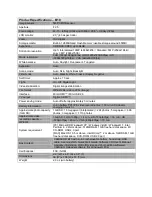
© INTEC Video Systems, Inc.
Revision F May 2013
9
6. It is recommended that you apply an anti-galvanic
compound to the camera mounting bolts before
installation.
7. The CVC500AH Hirose connector is a push to
lock type. Simply align the arrow on the cable
connector with the one on the camera connector and
push until firmly seated.
8. Once seated secure the main cable with the cable
clamp provided.
To disconnect the cable, pull back on the cable
connectors locking end as shown in the next
diagram.
The CVC500AHXL connector is a twist to lock type.
Simply align the keys on the cable connector with
the ones on the camera connector and push in and
twist until firmly seated.
Cable Installation
The following are general tips and precautions to
keep in mind while routing the cable between the
camera and controller or the controller and display.
With the exception of Molex connectors (found on
the CVU and CVXLP series cable harnesses), the
entire cable is weatherproof and can withstand
exposure to cold (down to -40 degrees F), rain,
snow, dirt, etc. If you feel the environment in which
the cable is exposed is extremely harsh, you can
route the cable through a conduit or consult INTEC
about our optional application cable harnesses for
extreme temperature or environmentally challenging
applications.
If exposed to the environment, the Molex connectors
must be weatherproofed. A simple means is to use
1-inch diameter gum interior heat shrink tubing
(available from INTEC) to cover the whole connector
assembly. This will seal and protect the connector
from direct moisture due to rain, snow, vehicle
washing, etc. Weatherproof junction boxes, properly
sealed, are another means. One should occasionally
check the seals to make sure they remain intact.
We recommend using the waterproof XL or H cables
and connectors so that heat shrinking is not
necessary.
DO NOT use electrical tape, slotted plastic conduit
or silicon only as a weatherproofing. They may
protect the connector for a short period of time but
will quickly lose their ability to keep moisture away
from the connector and pins.
Other cable installation hints include:
1) Do not attach the cable to moving vehicle parts.
2) Keep the cable at least 12 inches away from any
significant source of heat.
3) Avoid running the cable along the same side of
the chassis as the ABS wiring.
4) Route the cable where it is protected from road
debris or overhead hazards.
5) Secure the cable so that vehicle vibration and
shock do not loosen it. Tie the cable down
approximately every 12 - 18 inches. Insulated P-
clamps are recommended where appropriate.
6) Secure the cable on both sides of a pivot point
allowing enough cable to extend fully but not so
much as to cause snagging. Run the cable to avoid
getting caught in the pivot point.

































